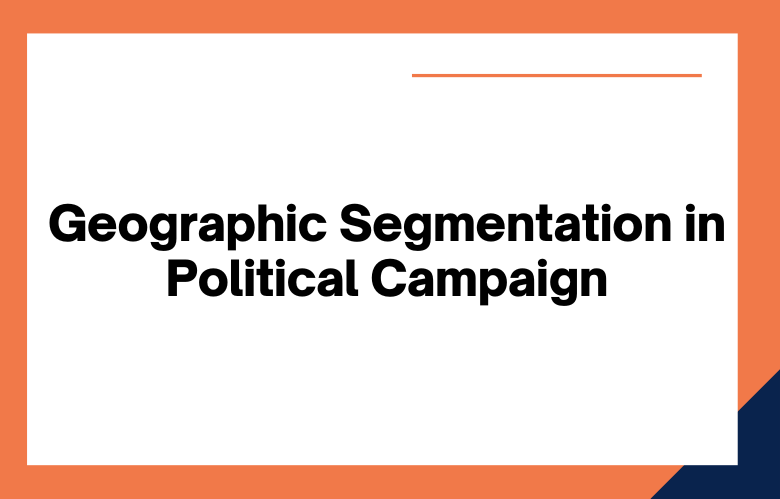The world is getting smaller every day. With the advent of the internet and social media, people from all corners of the globe are now connected like never before. This increased connectivity has led to a more informed and globally conscious citizenry. As a result, businesses and organizations must adapt their marketing strategies to appeal to this new breed of customer. The only method to do this is by using geographic segmentation.
Geographic segmentation is dividing the world into distinct regions or markets and tailoring your marketing efforts to each one. This enables you to understand the needs better and wants of your target market and tailor your message accordingly.
When applied to political campaigns, geographic segmentation can be a powerful tool for winning over voters. Understanding voters’ priorities in different regions allows you to fine-tune your campaign message to appeal to them. In this article, we’ll explore how you can use geographic segmentation in your political campaign.
What is Geographic Segmentation?
Geographic segmentation is dividing voters into groups based on their geographical location. This can be as specific as their zip code or as broad as their state or country of residence. The purpose of geographic segmentation is to allow campaigns to tailor their message and strategies.
For example, if you are running for office in a large state like California, you will need to consider the different geographical regions of the state when crafting your message.
In Southern California, voters may be most concerned with issues like traffic congestion and affordability, while voters in Northern California may be more focused on environmental issues. By tailoring your message to each region’s specific needs, you can ensure you resonate with voters across the state.
How to Use Geographic Segmentation in Your Campaign
Below are the steps that you will need to follow to use geographic segmentation in your campaign effectively:
- You will need to identify the critical geographical areas you want to target.
- You will need to research the unique needs and concerns of each area. Once you understand each region, you can start crafting tailored messages addressing the issues that matter most to voters in each room.
- You must ensure your campaign team is adequately trained to execute your geographic segmentation strategy.
By following these steps, you can create a targeted campaign plan to win over voters in every corner of your district.
Understand Your Target Market
Understanding your target market is the first step in applying geographic segmentation to your political campaign. What are their needs and wants? What are their priorities? You need to understand your target market before you can begin tailoring your message to them.
Define Your Regions
The next step is to define your regions. What geographical areas do you want to target with your campaign? This will be based on many factors, such as the size of your budget and the resources at your disposal. Once you’ve defined your regions, you can tailor your message to each one.
Tailor Your Message
Now that you understand your market and have defined your regions, you can begin tailoring your message. What messages will resonate with voters in each area? What issues are they most concerned about? How can you frame your campaign in a way that appeals to them?
By tailoring your message, you’ll be able to better connect with voters and win their support.
How Does Geographic Segmentation Work?
It divides a market into smaller geographic units such as countries, states, or cities. This type of segmentation allows a business or organization to better tailor its products, services, or message to each geographic area’s specific needs and wants.
We can find several ways to segment a market geographically. The most common method uses demographic criteria such as population density, income level, age, or gender.
Other methods include using psychological criteria like lifestyle or personality type. Businesses can also segment markets by behavior, such as purchasing habits or media consumption patterns.
Why Is Geographic Segmentation Important?
Geographic segmentation is essential for political campaigns because it allows them to target their efforts accurately.
By understanding the demographics of different regions, campaigns can tailor their messages to resonate with voters in those areas. Additionally, geographic segmentation can help campaigns save money by targeting areas more likely to vote for their candidate.
Benefits of Geographic Segmentation
Several benefits come with using geographic segmentation in political campaigns. First and foremost, it allows campaigns to target their audience better. By understanding the demographics of different regions, campaigns can tailor their message to better resonate with voters in those areas.
Another benefit of geographic segmentation is that it can help campaigns identify swing regions. Swing regions are areas where the vote is expected to be close and could potentially go either way. By identifying these regions early on, campaigns can allocate extra resources toward them to sway the vote in their favor.
Geographic segmentation can also help campaigns keep track of their progress over time. By tracking how regions respond to the campaign’s messaging, they can adjust their strategy accordingly and ensure they’re on their way to winning the most votes possible come election day.
There are several reasons why geographic segmentation can be an effective tool in political campaigns:
- It enables you to tailor your political message to the specific needs of each region.
- It makes targeting specific voter groups that might be more receptive to your message more accessible.
- It allows you to communicate with voters in their language and dialect. Voters in their language and dialect.
Drawbacks of Geographic Segmentation
There are also some drawbacks to using geographic segmentation in political campaigns:
- It can be expensive to tailor your message to multiple regions.
- Knowing which issues are most important to each area can be challenging.
- It can be easy to overextend yourself and alienate voters instead of winning them over.
The Basics of Geographic Segmentation
Geographic segmentation is the process of dividing up the electorate by geographic region. This can be done at various levels, from country to state to county to city. The goal of geographic segmentation is to target your message more and tailor your campaign strategy to the needs of specific voters.
There are several different factors that you need to take into account when you’re doing geographic segmentation. First, you need to get the demographics of each region. What is the population density? What is the average income? What are the voting patterns in each area?
Second, you need to consider the critical local issues in each region. What are the top concerns of voters in each area? Third, you must consider what media coverage is available in each part. What newspapers and television stations serve each area?
Applying Geographic Segmentation in Your Campaign
Once you understand geographic segmentation basics, you can apply it to your campaign. There are different methods that you can do this.
One way is to target specific media markets with your advertising. This can be done by buying advertising time on local television stations or in local newspapers.
Another way is to have different versions of your campaign website for other regions. This allows you to customize your message and content for each area. Finally, you can use direct mail and canvassing to target specific areas with your campaign message.
Conclusion
In today’s interconnected world, businesses and organizations must adapt their marketing strategies to appeal to a more globalized customer base.
When applied to political campaigns, geographic segmentation can be a powerful tool for winning over voters.
Understanding voters’ priorities in different regions allows you to fine-tune your campaign message to appeal to them. In this article, we’ve explored how you can use geographic segmentation in your political campaign.
Understanding your target market thoroughly and tailoring your message accordingly will increase voter engagement and win more support for your candidacy.











